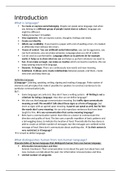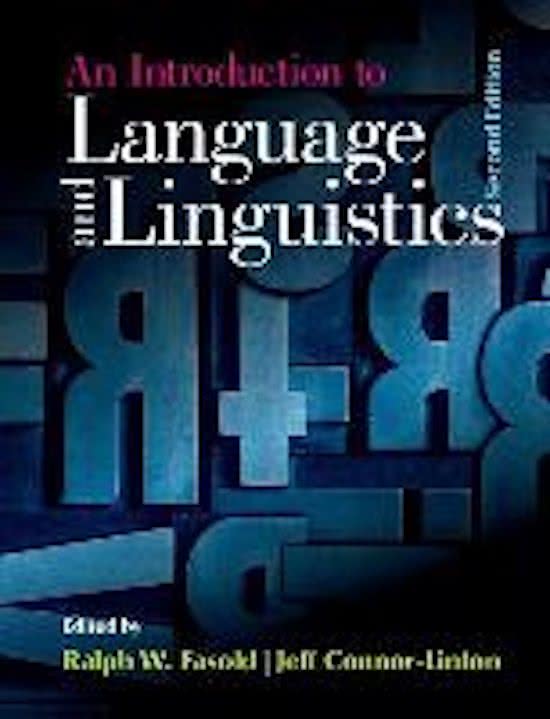Introduction
What is language?
To create or express social belonging. People can speak same language, but when
you belong to a different group of people (social class or culture), language use
might be different.
Talking to lecturer VS toddler.
Very expressive. We can express scenes, thoughts, feelings and needs.
Create our identity
Affects our credibility. If you hand in a paper with a lot of spelling errors, it is looked
at differently than without the errors.
Means of control. You can withhold verbal information, you can be aggressive, you
can hurt someone, you can praise someone. Language gives us a lot of control.
Can be used as a performative. Language allows us to perform (in for example
work), it helps us to show what we can and helps us perform whatever we need to.
Fun. It can make us laugh, can make us creative which can lead to reactions. We can
enjoy playing around with language.
Dynamic. It changes. There are continuously new words and new meaning.
Relational. It allows us to create relationships between people, end them, create
new ones and keep them up.
Definition language
A language= Listening, speaking, writing, signing and reading a language. Finite system of
elements and principles that make it possible for speakers to construct sentences to do
particular communicative jobs.
BUT:
Some languages are only oral, they don’t have a writing system. Writing is not a
criterium for being a language. How else can we define language?
We also say that language communicates meaning. But traffic signs communicate
meaning as well. We wouldn’t talk about these signs as a form of language, but
more as signs with an agreed upon meaning. A parrot can speak as well, but for him
the words don’t carry meaning. He can only reproduce sentences that have been
taught to him. Is any communication that carries meaning language?
Bees have a communication system that relies on a dance to communicate the
direction and quality of food. The bee uses a specific repetition of basic patterns and
a tail waggling dance to indicate the location of food. Theoretically the bee dance is
able to create an infinite number of messages, but the messages are confined to the
message of food. Bees don’t communicate about anything else. So their system is
very restricted, is it language?
It is hard to define language.
What distinguishes human from non-human language?
Characteristics of human language that distinguish human from non-human language :
Information beyond place and time
Animals (monkeys): Their communication is not about the past, but about here and
now. Humans can talk about the past. Our information is beyond place and time.
Limited number of categories
, - For animals limitation is really large
Only communication bees have is direction they fly to and their movements.
- Human language and sign language are unlimited. Human language consists of a
finite number of signs that can be combined to create an infinite number of
meaningful units.
- Double articulation= The fact that humans have different levels of conveying
meaning: through meaningful signs (words and morphemes) and distinctive
elements (sounds and morphemes).
Plural s is a single sound, but can make a big difference House/houses.
Discreteness
Every language has its own set of discrete units (phonemes, morphemes, words,
phrases etc.). Discreteness divides the stream of language into discrete units.
Different for each language.
Japanese learning English have difficulty between the L-sound and the R-sound. In
Japanese there’s no difference between the two. There’s no difference in meaning.
Pet and Pat have different meanings in English, however in German those 2 different
sounds don’t make a difference in meaning.
Inuit have a lot of different words for snow. In English we don’t have that. In Inuit
snow is more important, which is why they have more words than we.
Productivity
- We can produce an infinite number of sentences and our sentences can be
infinitely long, but our brain has a limited capacity and at some stage we get lost
and don’t understand sentence anymore.
A brilliant, colourful, original, skilfully designed, beautifully framed…picture.
- Language is infinitely productive and new words are created all throughout
society and history. New words are created following rules and native speakers
know about these words. Some words created remain in a particular domain
(restricted to teenagers), but some also make it to a larger domain.
Arbitrariness (willekeurig)
Arbitrariness= There is no relation between the sound and meaning of a word.
There’s no reason for it. There’s no reason why we should call a chair a chair.
Onomatopoeic words are supposed to sound as natural sounds and they’re supposed
to be the same in different languages. But if we look at bells: In French ding dang
dong, in English ding ding dong, Dutch bim bam bom. So onomatopoeias are also
arbitrary.
Modularity
Language is modular system= Humans produce and interpret language using a set of
modules in a coordinated way. If we produce or try to understand language, we draw
on those different modules. Every of these modules is responsible for part of the
language production/perception process.
Modules: Phonetics, morphology, syntax, lexicon, pragmatics, discourse.
Two people at a dinner table have feelings for each other. One of them has feeling
that wants to tell the other how he feels about her. To decide how to do this, he has
to draw on different modules:
1. Conceptualization= To conceptualize situation. What is the feeling I have? How
do I convey the message?
2. Sentence formation= The different modules you go through
, 1. Finding the appropriate word. Do I say I love you, adore, I am into you?
2. Structuring the sentence. I have decided on the word love. How do I use love
in a word? We know it has S-V-O sentence structure.
3. Pronunciation. How do I pronounce this sentence?
Once you have drawn on all those modules, you have to articulate the
sentence (draw on articulation module) and draw on motor movement
(producing the sounds)
Context dependence of language
The word ‘bank’ means land alongside the river and organization that provides
financial services. Context can decide which one you’re talking about. When
you’re close to a river, it is about the first meaning.
Constituency and recursion
- All languages organize basic discrete units into constituents (groups of linguistic
units) which allow more complex units to be put in the sentence where simpler
units are also possible.
She gives a lecture and The woman with the dark glasses gives a lecture.
- They are all the same constituent in this sentence, as they form the subject. You
can extend or shorten this constituent, but you cannot change a constituent for
something that is not a constituent:
The woman was tall, pretty, smart, educated and talented. All the italics words
are constituents and you can go on forever.
- Constituency allows for flexibility and structure.
- Constituency allows for recursiveness= The ability to add up constituents of the
same type infinitely.
Variability
- Languages of the world share some universal characteristics, but there are
differences between individual languages and differences between speakers of
the same language.
- There is also a difference in language use of individual speakers depending on
situation and people you are speaking to (toddler vs adult).
What is communication?
Communication= The process of sharing information, especially when this increases
understanding between people or groups.
Communication is about exchanging information. The process of using symbols to
exchange meaning.
Chimpanzees exchange information and meaning as well, but the type of information
is restricted to the here and now, while human language can communicate about
different times and places.
Non-human communication
Apes use gestures, which are largely innate (they don’t have to learn them but know
them when born. Over time some new gestures can be learned).
Gestures are used intentionally (apes know they want to tell a fellow ape something)
Intentional gestures are used to request/demand actions from others (getting
attention, demanding action).
Apes only use communication for their own goals. They don’t have shared goals.
, I see something there and this is what is going to happen next, but nothing beyond
that.
Human communication
Human communication is more complex because social-cognitive infrastructure not
only covers skills for understanding individual intentionality, but skills for shared
intentionality.
Humans can express joint goals.
We use our accumulated experience/memory to generate expectations, goals, but
also joint attention. Here our communication is related to our experiences in the
past.
Humans have motives for shared intentionality: we can request something, inform
someone, share emotions and share attitude.
The general underlying principle: Cooperation (we want to work) and intentionality
(we want to achieve a goal). One of the joint goals we have: successful
communication, so that our communication works.
Model of communication
Linear model
Sender= Person who encodes a message and sends this message to a receiver through a
particular channel. The sender is the initiator of communication.
Receiver= Receives the message and has to decode the message so that it makes sense to
him.
You’re in the street and see a friend who makes eyecontact, smiles, waves and says hello
receive message that is intended for you you have to encode verbal and non-verbal part of
the message.
Message= Particular meaning/content the sender wishes the receiver to understand. Can
be intentional or unintentional.
You’re sitting in a lecture theatre, yawning, you might not want to communicate that you’re
not very interested in the lecture, but you do.
Messages can be verbal/non-verbal and written/spoken.
Verbal and non-verbal methods can be combined.
Channel= The method the sender uses to send a message to receiver. Most common
channel is human verbal and non-verbal communication, but other channels are TV,
telephone etc.
Noise= Anything that interferes with the sending and receiving of a message. Noise can be
external (people working outside on road works not allowing you to hear the other person)





